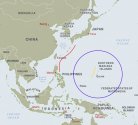If possible, can you please draw it on the map?
How exactly US can forward-deploy assets(and which assets) to maintain 24/7 patrols over open swaths of western Pacific?
I don't have the talent to annotate maps very well.
In terms of the geography of the outermost and middle layers, depicted as the red line, the bulk of US air and naval assets deployed would operate at about that region.
Naval forces at that location would consist of 2-3 CSGs and 3-4 SAGs, which will exert organic sea based CAP and AEW&C as well as surface combatant oriented air surveillance consisting primarily of high end SPY-6 equipped ships.
Ground based air forces would be operating from first island chain air bases in Japan and the Philippines, where land based CAP and AEW&C would operate. Those air bases, as well as other smaller islands in the first island chain would be home to mobile deployable ground based IADS sensors and SAM batteries.
In terms of the final layer, I envision a naval picket at about the orange line consisting of 1-2 CSGs and 2-3 SAGs acting as a reserve/relief force as well as a final mobile air-naval defensive force for Guam. Guam itself of course would be defended by its own extensive IADS on the island.
Assuming that H-20s can carry an air launched weapon with a range of 1500km range, then they would have to approximately approach the blue circle to deploy its payload -- and to fly back to China.

I think that against the sort of frontloaded force that the US will deploy in the first island chain, and the distances involved, that a sufficient force of H-20s would be able to successfully ingress past US air-naval-ground forces and deploy a sufficient number of weapons, and successfully fly back to China, without first fighting a very very substantial air-naval-missile campaign in the first island chain to begin with to blow significant holes in the US lines of defense.
The original suggestion was that 30 H-20 sorties per 12 or 24 hours could cripple Guam at the outset of a conflict. I am saying that I don't think that's likely, given the extent of forward deployed US forces that will exist between the Chinese mainland (around the first island chain) and Guam.
I think the PLA would have to blow significant holes in US defensive lines first before they are able to carry out a successful H-20 raid of sufficient scale against Guam.
... and this all arose from my original belief that going forwards the assets most likely to be able to successfully conduct a strike against Guam at the outset of conflict would be SSN/Gs with a large SLCM and sub launched HGV complement, that has a pre-existing long term peacetime presence in the pacific around Guam (especially on its southern and eastern sides), operating in conjunction with other long range land based strike methods that the PLA possesses (IRBMs and HGVs, and possibly H-20s).
